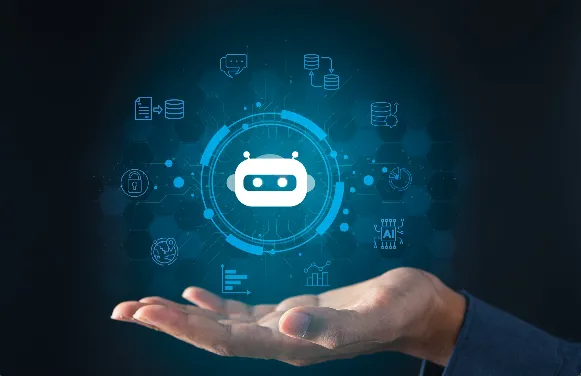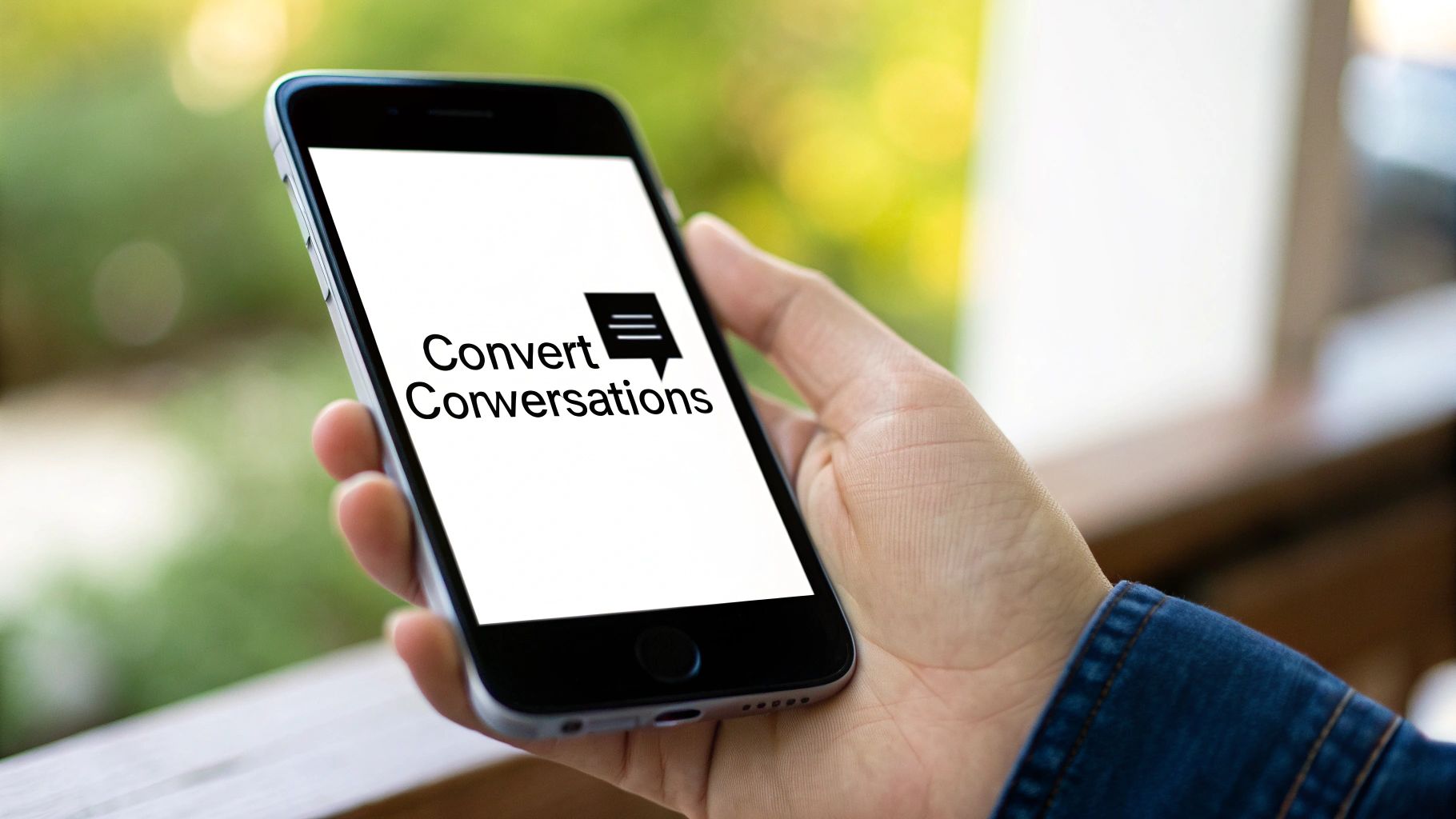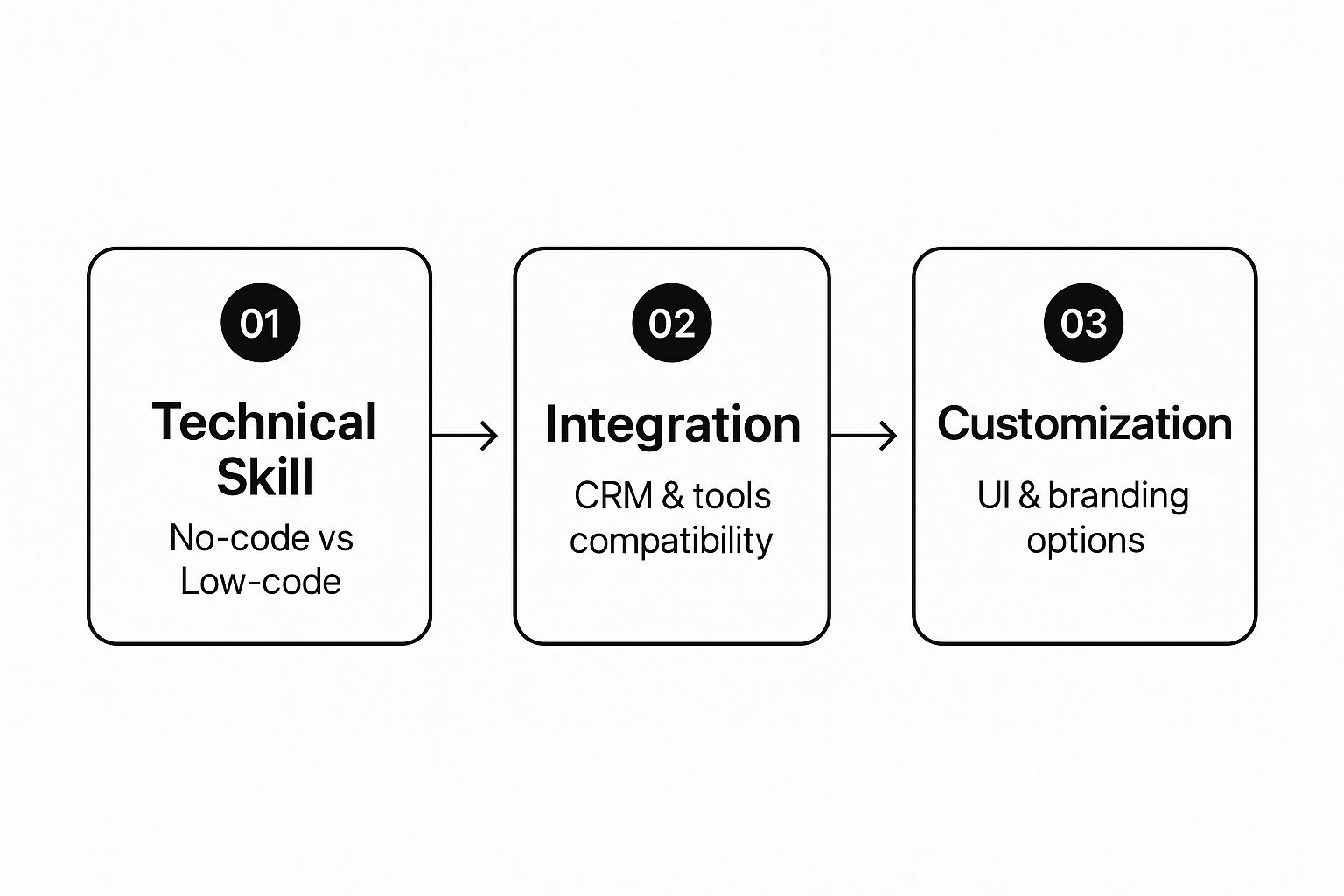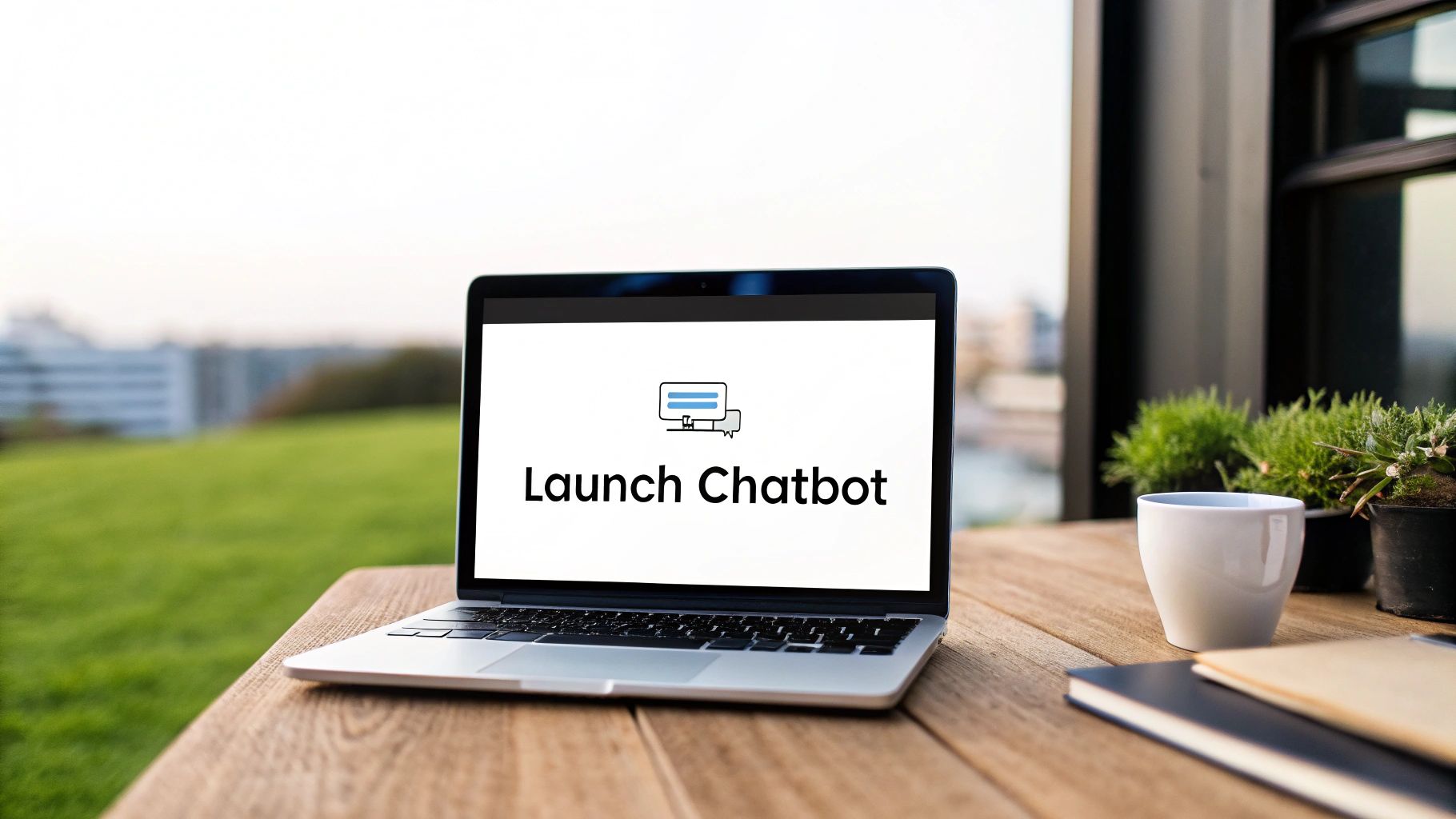
Chatbots for Lead Generation Your Ultimate Guide
Chatbots are your secret weapon for lead generation. Think of them as automated conversational tools that engage your website visitors the moment they arrive, collecting their information and qualifying them as potential leads, day or night. They turn your static website into an interactive experience, answering questions on the spot and guiding users down the sales funnel. This dramatically cuts down the time it takes to turn a curious visitor into a qualified lead compared to old-school contact forms.
Why Chatbots Are Your New Sales Superpower
Your website is your digital storefront, but is it working as hard as it could be? For many businesses, it’s a passive experience. People show up, look around, and leave without ever saying a word. Relying on a "Contact Us" form is like having an empty storefront with a note on the door telling customers to come back later. This is where chatbots completely change the game.
Instead of making a potential customer hunt for a form, a chatbot starts a helpful conversation as soon as they land on your site. It’s the digital version of a great salesperson asking, "Hi there, what can I help you find today?" That immediate engagement is everything. In fact, just a five-minute delay in responding to a lead can tank your qualification odds by a staggering 80%. Book A Call

From Passive Forms To Proactive Conversations
Let's be honest, traditional lead forms are a one-way street. They ask visitors for their information without giving anything back right away. Chatbots flip that script by providing value first.
Imagine a potential customer for your software company is checking out your pricing page. They have a question about an integration they don't see listed.
The old way (with a form): They have to navigate to your contact page, fill out a bunch of fields, hit submit, and then... wait. It could be hours, or even days, before they get an email back. By that time, they’ve probably already found a competitor who was quicker to respond.
The new way (with a chatbot): A friendly window pops up: "Have a question about our integrations?" The visitor types their question and gets an answer instantly. The bot can then follow up with a qualifying question like, "What CRM are you using?" and smoothly offer to book a demo with a sales specialist.
This is a much smoother, more satisfying experience. It doesn't just capture the lead; it pre-qualifies them, which saves your sales team a ton of time.
The Power Of 24/7 Availability
Your team might clock out at 5 PM, but your website is always on and so are your potential customers. A chatbot for lead generation acts as your tireless, around-the-clock sales assistant, making sure you never miss an opportunity, even if it comes in on a Saturday night. This is a huge advantage when you consider that only 37% of companies manage to respond to new leads within an hour.
This isn't just about being convenient; it's about getting a serious edge over the competition. By offering instant help whenever someone needs it, you create a fantastic first impression. Prospects feel heard and valued, which builds trust long before they ever talk to a human. For more practical ideas, you can check out these 25 ways chatbots help small businesses win more deals and increase revenue faster.
The market trends speak for themselves. The global AI chatbot market has exploded, jumping from $2.47 billion in 2021 to a projected $15.57 billion in 2025. This incredible growth, tracked by platforms like Exploding Topics, shows just how many businesses are realizing that chatbots are essential for cutting costs and generating more leads.
"A chatbot’s primary role in lead generation is to reduce friction. By answering questions instantly and guiding users toward the right solution, it removes the barriers that cause potential customers to abandon your site."
Chatbots vs Traditional Lead Forms
When you stack them side-by-side, the advantages of a chatbot over a static form become crystal clear. Chatbots create a dynamic, two-way conversation that feels more personal and delivers immediate value, which is exactly what modern customers expect.

Ultimately, while forms have their place, chatbots are a far more powerful tool for engaging visitors, qualifying them effectively, and accelerating your sales cycle from the very first click.
Designing Conversations That Actually Convert
A chatbot built for lead generation can't just be a glorified contact form. It needs to be a skilled conversationalist. The line between a bot that frustrates visitors and one that consistently brings in qualified leads is drawn by the quality of its conversation design. It should feel less like an interrogation and more like a genuinely helpful chat.
The real goal here is to guide someone from a casual "hello" to a qualified lead smoothly and without friction. This means thinking ahead, anticipating their questions, speaking their language, and making the whole process feel natural.

This example from Drift is a perfect illustration. The bot uses quick-reply buttons to immediately figure out who the visitor is and what they need. This guides them down the right path from the very first click, making the interaction fast and effective.
The big takeaway? You don't need long, typed-out answers. By offering clear choices, the bot stays in control of the conversation while making the user feel empowered. This is a core principle of good conversation design. For a deeper dive, exploring different strategies for designing a chatbot conversation flow can give you a solid playbook to start with.
Crafting a Compelling Opening Hook
You've got maybe three seconds to grab a visitor's attention. Your chatbot's opening line is everything. A lazy, generic "How can I help you?" is easy to ignore because it puts all the work on the user to get the ball rolling.
Instead, a great hook is proactive and understands the visitor's context. It shows the bot knows exactly why they're on that specific page and offers immediate value.
Think about these real-world scenarios:
On a Pricing Page: Don't just say hello. Try, "Finding the right plan can be tricky. Want some help comparing our options?" This hits on a common pain point for anyone looking at pricing.
On a Product Features Page: Get specific. A hook like, "Curious how our analytics feature stacks up against the competition? I can show you a quick comparison," offers something valuable right away.
On the Homepage: For a new visitor, guide them from the start. "Welcome! Are you looking for a solution for your marketing team or your sales team?" This kicks off the segmentation process instantly.
The best opening lines aren't really questions they're invitations. They make it incredibly easy for the user to just say "yes" and start the journey. Book A Call
"A great conversation design anticipates the user's next question and answers it before they even have to type. It's about being one step ahead, providing clarity and direction at every turn."
Qualifying Leads Without Being Pushy
Once you've hooked them, it's time to qualify them. The secret is to make this feel like a natural part of the conversation, not like you're just trying to grab their data. Asking for their name, email, and phone number all at once is just a clunky form in a chat window. That’s a huge turn-off.
The trick is to weave your qualifying questions into the flow of the chat. Ask things that give them value while also giving you the information you need.
Start Broad: Kick things off with questions about their goals or challenges. If you're a marketing agency, you might ask, "What's your biggest marketing challenge right now? Is it generating leads, boosting website traffic, or something else?"
Gather Context: After they share a pain point, you can dig a little deeper. "Got it. To give you the best advice, could you tell me a bit about your company size? Are we talking 1-10 employees,11-50, or 50+?" This helps you see if they fit your ideal customer profile without being intrusive.
Ask for Contact Info Last: Don't ask for an email or phone number until it’s the logical next step. For example, you could say, "It sounds like our 'Pro Plan' would be a perfect fit. Where can I send the detailed feature list and a special discount code?" This frames the request as a benefit for them, not just a demand from you.
Designing a Seamless Handoff
Look, not every conversation can or should be 100% automated. Knowing when to get a human involved is absolutely critical for converting high-intent leads. A fumbled handoff is incredibly frustrating for a potential customer and can cost you a major opportunity.
Your chatbot needs to be smart enough to recognize the perfect moment to escalate the conversation.
Set Up High-Intent Triggers: Create rules for specific keywords. When a user types things like "pricing," "demo," or "speak to sales," the bot should immediately offer to connect them with a live agent.
Manage Expectations: If your team isn't online 24/7, be upfront about it. The bot can say, "Our sales team is offline at the moment, but they'll be back at 9 AM ET. Can I book a time on their calendar for you?"
Provide Full Context: Make sure the entire chat transcript gets passed along to the human agent. There's nothing worse for a user than having to repeat everything they just told the bot. Your team member should be able to see the full conversation and jump right in without missing a beat.
By thoughtfully designing these three stages the hook, the qualification, and the handoff—you create an experience that doesn't just generate leads. It builds trust and sets a positive tone for the entire customer relationship.
Choosing the Right Chatbot Platform for Your Business
Picking the right technology for your lead generation chatbot is a huge decision, but it doesn't have to be overwhelming. The market is flooded with options, each designed for different business needs, budgets, and technical abilities. Your job is to find a platform that not only captures leads but also plugs right into how you already work.
The first big choice you'll face is between simple, rule-based chatbots and more sophisticated AI-powered ones.
Rule-based bots are essentially interactive flowcharts. They guide users through a conversation using buttons and predefined paths, much like an automated phone menu. They're simple to set up, affordable, and perfect for straightforward qualifying questions. For many small businesses, this is the ideal starting point.
AI chatbots, however, are a different beast. They use Natural Language Processing (NLP) to actually understand what users are typing, allowing for more natural, free-flowing conversations. They can handle unexpected questions and complex scenarios, which is a massive plus if your customers have a wide range of needs.
Your Technical Comfort Zone: No-Code vs. Low-Code
The first question to ask yourself is: "Who is going to build and manage this thing?" The answer will help you narrow down the field immediately. The good news is, you don't need a developer on standby.
No-Code Platforms: These are built for the rest of us marketers, founders, and sales managers. Think drag-and-drop editors, ready-made templates, and simple interfaces. If you can create a PowerPoint slide, you can build a chatbot. Platforms like Tidio or Intercom are great examples. They're all about getting you up and running fast.
Low-Code Platforms: This is the middle ground. These tools offer the same visual builders but also let you inject custom code or connect to APIs for more complex tasks. It's the right choice if you have someone with a bit of technical skill who wants more control than a no-code tool can offer.
This visual breaks down the key decision points you'll encounter as you shop around.

As the infographic shows, it’s all about finding that sweet spot between your technical resources, integration needs, and branding goals. Book A Call
"The best platform isn't the one with the most bells and whistles; it's the one your team will actually use. Always prioritize ease of use. A simpler tool that gets launched is infinitely better than a complex one that never leaves the draft stage."
Must-Have Integration Capabilities
A chatbot that doesn't talk to your other software is just a fancy website widget. To be a true lead generation machine, it has to feed information directly into your sales and marketing ecosystem. Otherwise, you’re just creating more manual data entry for your team, and nobody wants that.
Before you pull the trigger on any platform, make sure it plays nice with your essential tools:
Your CRM: The chatbot absolutely must be able to push lead data name, email, company, and even the chat transcript—directly into your CRM, whether it's HubSpot, Salesforce, or Zoho. This gives your sales team instant visibility into new leads.
Email Marketing Software: Look for native integrations with services like Mailchimp or ConvertKit. This allows the bot to automatically add new contacts to the right email campaign based on their needs.
Scheduling Tools: This is a game-changer. An integration with a tool like Calendly lets qualified leads book a demo or sales call right there in the chat window. It’s frictionless and eliminates all the back-and-forth scheduling emails.
The ability to connect with other apps is a huge signal of a platform's value. Without it, you're building an island.
Customization and Branding Options
Finally, remember that your chatbot is a direct reflection of your brand. A generic bot with default colors and a robotic greeting can feel cold and untrustworthy.
A good platform will give you full control over the look and feel. You should be able to tweak the colors, fonts, and avatar to perfectly match your website's design. Just as important is the ability to define the bot's tone of voice. Do you want it to be professional and direct? Fun and quirky? Helpful and friendly?
Nailing the customization makes the chatbot feel less like a tool and more like a helpful member of your team. This builds trust and gets more visitors to actually engage with it.
Launching Your Lead Generation Chatbot
You've designed the conversation flows and picked your platform. Now comes the exciting part: actually getting your chatbot live on your website. The jump from planning to deployment can feel a bit technical, but most modern tools have made this surprisingly painless. In many cases, it's as simple as embedding a small piece of code.
Seriously, it's often just a matter of copying a code snippet from your chatbot provider and pasting it into your site's header or footer. If that sounds intimidating, don't sweat it. Platforms like Drift, Intercom, or Tidio provide dead-simple, step-by-step instructions for popular website builders like WordPress, Shopify, and Squarespace. You'll be up and running without having to write a single line of code yourself.

Strategic Placement And Targeting
Once the code is in place, the real strategy begins. You need to decidewhereandwhenyour chatbot should pop up. Just blasting it on every page for every visitor is a surefire way to annoy people. The goal is to make your bot a helpful assistant, not a disruptive nuisance.
Think about the high-intent pages where visitors are most likely to need help or be ready to take the next step.
Homepage:This is a great spot for a general welcome bot. It can act as a friendly guide, helping direct traffic and segment visitors right away.
Pricing Page:Someone on this page is clearly interested. A well-placed bot can proactively answer questions about plans, features, or billing, overcoming that last-minute hesitation.
Product/Service Pages:Use a bot here to offer deeper dives, share a demo video, or connect a qualified visitor with a sales specialist.
Beyond just picking pages, you need to set up smart targeting rules. These rules trigger your chatbot based on what a visitor is doing, making the interaction feel relevant and perfectly timed.
"The best chatbots feel like they've appeared at the exact right moment. Use behavioral triggers like time on page, scroll depth, or exit intent to start conversations when they're most likely to be welcomed."
To keep everything on track, a simple checklist can be a lifesaver. It helps ensure you haven't missed any crucial steps before you go live. Book A Call
Chatbot Deployment Checklist
Here’s a quick checklist to run through for a smooth and effective launch.

This checklist isn't just about ticking boxes; it's about building a solid foundation for a tool that will actively work for your business.
Fine-Tuning The Triggers For Maximum Impact
This is where you turn your bot from a static widget into a proactive engagement machine. For instance, triggering a message after a user has been on your pricing page for more than30 secondsis a fantastic way to engage someone who is clearly weighing their options.
Another powerful tactic is usingexit-intenttriggers. These launch the chatbot when a user’s cursor moves toward the back button or to close the tab, giving you one last shot to capture their attention—and their contact info.
This strategic approach has been particularly successful in e-commerce. As of 2025, a staggering77% of the most successful lead generation chatbotswere deployed by online stores. Why? The online retail sector has the highest consumer acceptance rate for chatbots at34%. It's a clear sign that well-timed, helpful bots really do drive sales. You can dig into morechatbot adoption rates across different industriesto see how this plays out elsewhere.
The Critical Role Of A/B Testing
Let me be clear: launch day is the starting line, not the finish line. To truly optimize yourchatbots for lead generation, you have to get comfortable with continuous testing. The opening line you thought was perfect might fall completely flat with your real-world audience.
Start by A/B testing a few key elements:
The Opening Hook:Pit a question-based opener ("Have questions about our plans?") against a statement-based one ("I can help you find the right plan in 60 seconds.").
The Call-to-Action (CTA):See what works better. Does "Book a Demo" outperform "Talk to an Expert"? Small wording changes can make a big difference.
Qualifying Questions:Experiment with the number and order of your questions. You might find asking for an email earlier works best, or maybe it performs better at the end of the chat.
By constantly testing and iterating based on real data, you'll transform your chatbot from a neat idea into a reliable, lead-generating machine that consistently delivers for your business.
How to Measure and Optimize Your Chatbot's Performance
Getting your chatbot live is a great first step, but it's really just the beginning of the journey. The real magic happens when you treat your bot less like a static tool and more like a dynamic lead-gen engine that gets smarter with every conversation.
To do that, you have to move past vanity metrics like "total chats" and zero in on the numbers that actually move the needle for your business.
Think of your chatbot as a digital salesperson working 24/7. You wouldn't let a human salesperson operate without tracking their performance, right? The same logic applies here. Without data, you're just guessing. With the right metrics, every tweak you make is a calculated move toward generating more and better leads.
Key Metrics That Truly Matter
Don't let yourself get lost in a sea of data. When it comes tochatbots for lead generation, a handful of key performance indicators (KPIs) tell you almost everything you need to know. These numbers paint a clear picture of how well your bot is grabbing visitors' attention and turning them into qualified prospects.
Start by getting a solid grip on these essentials:
Conversation Started Rate:What percentage of your website visitors actually start a chat? This is your first and most direct measure of your opening hook. If this number is low, your welcome message might not be compelling enough, or the bot itself might be hard to find.
Lead Capture Rate:Out of all the conversations that begin, how many end with the bot successfully getting an email or phone number? This KPI shows you how persuasive your conversational flow is at getting users to take that next step.
Lead Qualification Rate:This is the big one. What percentage of the leads you capture are genuinely qualified and get passed along to your sales team? This metric separates the real prospects from the window shoppers and reveals the true quality of your bot's output.
Cost Per Qualified Lead (CPQL):This is the bottom-line number your finance team will care about. Simply divide the monthly cost of your chatbot platform by the number of qualified leads it generated. This gives you a hard figure on your return on investment.
Once you start tracking these numbers, you'll have a powerful baseline. From there, you can begin making targeted improvements.
Analyzing Transcripts to Uncover Opportunities
Your chatbot's conversation history is an absolute goldmine of insight. I can't stress this enough: regularly reading through these transcripts is one of the best ways to understand what’s working and, more importantly, what isn't. You’re looking for patterns.
Specifically, hunt for drop-off points. Where do people consistently ghost the conversation? Is it when the bot asks for their company name? Or maybe when it presents a specific call-to-action? These friction points are your single biggest opportunities for improvement. If you see people bailing when you ask for a phone number, maybe try asking for an email instead.
"Reading through chat logs isn't just about debugging; it's about listening to the voice of your customer at scale. You’ll discover their real questions, their common objections, and the exact language they use all of which you can use to refine your bot's script."
Actionable Tips for Continuous Improvement
Optimization isn’t a one-and-done task; it’s an ongoing cycle of testing and refining. Using the data you’ve gathered from KPIs and transcript analysis, you can start making strategic changes to boost your bot's performance. The trick is to change one thing at a time so you can accurately measure its impact.
For some context, research suggests that AI-powered chatbots are incredibly effective. In 2025, they're projected to convert28% of website visitorsinto qualified leads—a massive jump over traditional web forms. This success comes from their ability to create instant, frictionless conversations. You can dig into more data on howAI chatbots are boosting conversion rates on amraandelma.com.
Here are a few high-impact areas to focus your efforts on first:
Refine Your Qualifying Questions:Are your questions too direct? Too vague? A/B test different phrasing. Instead of asking, "What is your budget?" try offering a multiple-choice format like, "Which of these best describes your monthly budget? <$500, $500-$2000, >$2000." It feels less intimidating and can seriously improve response rates.
Test Different Chatbot Behaviors:Experiment with your triggers. Does a bot that pops up after 10 seconds on the page outperform one that triggers on exit-intent? Try different welcome messages on your pricing page versus your blog to see what connects with each audience.
Incorporate Real User Feedback:Pay close attention to any conversation where a user types "speak to a human" or expresses frustration. These are flashing red lights indicating a broken flow or a gap in your bot's knowledge. Add new conversational paths or information to handle these queries better next time.
Consistentchatbot maintenance and optimizationare absolutely essential for long-term success. By regularly reviewing performance and making data-driven tweaks, you ensure your bot remains a powerful and efficient lead generation asset for years to come.
Still Have Questions About Lead Generation Chatbots?
Even after seeing all the potential benefits, it's natural to have a few questions before diving in. Honestly, it's smart to tackle these concerns head-on. Let's walk through some of the most common things business owners ask me when they're considering a chatbot.
Getting these answers will give you a solid foundation. You'll be able to move forward with confidence, knowing exactly how this tech fits into your strategy, your budget, and your existing website.
How Much Is This Going to Cost Me?
This is usually the first question, and the answer I always give is: it really depends. The price tag on a chatbot is tied directly to how complex you need it to be and which platform you use to build it. The good news? There’s an option for just about every budget.
If you’re just starting out, many no-code chatbot builders have plans that are incredibly affordable—some are even free, while others are in the$50-$100 per monthrange. These are perfect for getting the basics in place, like capturing lead info, answering simple questions, and scheduling demos. You get a ton of value without a huge upfront investment.
Once you’ve got the hang of it, you might look at mid-range solutions. These platforms typically run from$100 to $500 per monthand come with a lot more firepower. We're talking more advanced AI, deeper connections to your CRM, and a whole lot more you can customize.
For large companies or those needing something completely unique, a fully custom-built solution can run into the thousands for the initial development, plus ongoing fees for maintenance.
"My advice is always to start small. Pick a platform that fits your immediate needs and budget. Once you see a clear return on your investment, you can always upgrade to a more powerful plan."
Will a Chatbot Tank My Website's SEO?
I hear this concern a lot, but let me put your mind at ease. A well-implemented chatbot won't hurt your SEO. In fact, it can actually give it a nice, indirect boost.
Think about it from Google's perspective. Search engines want to see that users are having a good experience on your site. A chatbot helps with that by giving people instant answers and keeping them engaged longer. This increase intime on pageand lowerbounce rateare great signals to Google that your site is valuable.
There is one technical caveat, though:page load speed. A poorly built, clunky chatbot widgetcouldslow your site down, and that's definitely bad for SEO. Thankfully, most modern chatbot platforms are built to be lightweight and load asynchronously, which just means they don’t get in the way of the rest of your page loading. As a best practice, always run a speed test right after you install a chatbot, just to be safe.
What's the Real Difference Between a Rule-Based and an AI Chatbot?
The core difference here is all about how they "think." Getting this distinction right is key to picking the tool that will actually work for your lead gen goals.
Arule-based chatbotis the more straightforward of the two. It operates on a script you create, kind of like a digital flowchart.
It follows a strict "if this, then that" logic.
It only understands specific keywords or button clicks it’s been programmed to recognize.
It's fantastic for simple, direct tasks like booking a meeting or pointing a user to a specific pricing page.
AnAI chatbot, on the other hand, is much more dynamic. It uses technology likeNatural Language Processing (NLP)to understand theintentbehind what someone types, not just the literal words.
It can figure out what a user means, even with typos or slang.
It actually learns from conversations to get better over time.
It can handle complex, open-ended questions and make the conversation feel much more natural and personalized.
For generating and qualifying leads, AI chatbots usually have the upper hand. They can adapt the conversation on the fly, making the whole experience feel less like a form and more like a helpful chat.
Ready to turn your website into a 24/7 lead generation machine? At Engage AI, we specialize in creating custom chatbot solutions that capture, qualify, and convert visitors into valuable leads.Discover how our AI-driven strategies can accelerate your business growth today.
